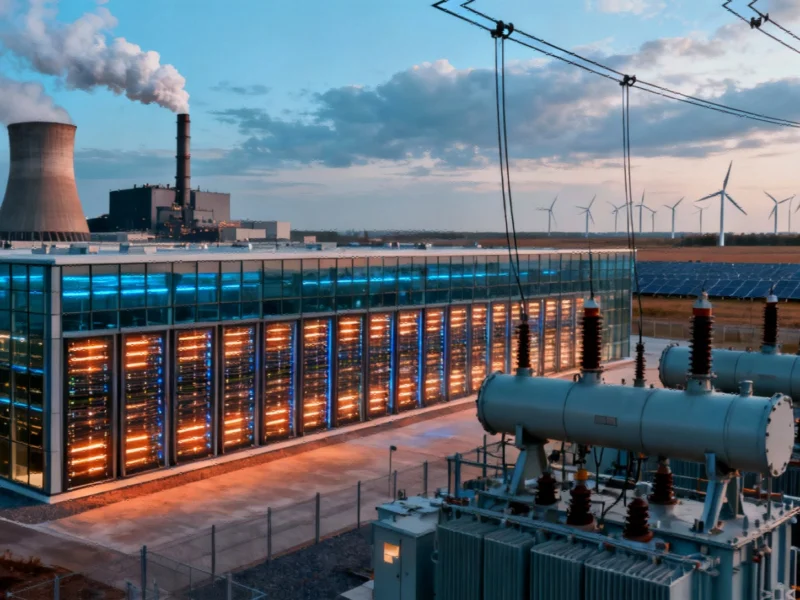The Grid Reality Check
Electric utilities across North America are facing an unprecedented challenge: distinguishing between genuine AI-driven power demand and speculative projections that may never materialize. As artificial intelligence companies announce massive data center projects, grid operators are discovering that many of the same projects are being shopped to multiple utilities simultaneously, creating a distorted picture of future electricity needs.
“We’re witnessing a phenomenon where identical-looking projects with the same power requirements are appearing in interconnection queues across different regions,” noted Brian Fitzsimons, CEO of GridUnity, whose software tracks power project requests across the U.S. electric grid. This duplication is forcing utilities to question which projects represent real, committed load versus speculative placeholder applications.
The Regulatory Warning Signs
Federal Energy Regulatory Commission Chairman David Rosner sounded the alarm in September, emphasizing that even small percentage variations in load forecasts “can impact billions of dollars in investments and customer bills.” His predecessor, Willie Phillips, who chaired FERC from 2023 until April 2025, echoed these concerns, telling CNBC that some regions have already scaled back their initial projections after realizing the speculative nature of certain AI power requests.
The stakes are enormous. Utilities must balance preparing for potential massive load growth against the risk of overbuilding infrastructure that would burden ratepayers with unnecessary costs. This delicate balancing act comes as electricity prices continue rising due to existing supply-demand imbalances across multiple regions.
The Industry Pushback
Some energy executives are becoming increasingly vocal about what they perceive as inflated demand projections. Constellation Energy CEO Joe Dominguez used his company’s May earnings call to deliver a blunt assessment: “I just have to tell you, folks, I think the load is being overstated. We need to pump the brakes here.” This sentiment reflects growing skepticism among power generators about the timing and scale of AI-related electricity demand.
The challenge extends beyond simple demand forecasting. As utilities evaluate these industry developments, they must consider the operational characteristics of AI data centers, which require both massive amounts of power and exceptional reliability—often demanding 24/7 operation with minimal tolerance for interruptions.
The Transmission Bottleneck
Compounding the uncertainty is the fragmented nature of the U.S. transmission system. AI companies are seeking the fastest possible connections to the grid, leading them to approach multiple utilities simultaneously. This creates a situation where regional grid operators see what appears to be separate projects when they might represent the same ultimate load.
The situation highlights the need for better coordination in power grid planning and forecasting as the industry navigates this unprecedented transition. Without improved visibility into which projects represent genuine commitments, utilities risk either underbuilding and creating reliability issues or overbuilding and imposing unnecessary costs on consumers.
The Ripple Effects
The uncertainty surrounding AI power demand is creating secondary effects throughout the energy ecosystem. Regulators are grappling with how to approve rate cases and infrastructure investments without clear demand signals. Renewable energy developers are trying to determine whether to accelerate project timelines or adopt a more cautious approach.
Meanwhile, the broader technology sector continues to evolve rapidly, with AI implementations moving from experimental phases to practical enterprise applications that may have different power characteristics than initially projected. This evolution adds another layer of complexity to demand forecasting.
The Path Forward
Industry experts suggest several approaches to resolving the uncertainty. Better data sharing between utilities and standardized reporting of project status could help distinguish between speculative and committed projects. Some regions are implementing stricter requirements for interconnection applications, including larger financial commitments that demonstrate serious intent.
The situation also highlights the importance of robust security and reliability planning for critical infrastructure that supports both AI operations and the broader grid. As these systems become more interconnected, the consequences of misjudging demand or capacity become increasingly severe.
Other sectors are watching these developments closely, as the resolution of AI power demand uncertainty will influence broader supply chain and manufacturing investment decisions. The outcome will determine whether billions of dollars in energy infrastructure investments are deployed effectively or wasted on unnecessary capacity.
Broader Implications
The AI power demand question intersects with multiple other industry trends. The ongoing evolution of AI ethics and governance frameworks may influence which applications ultimately consume power, while advancements in AI efficiency and multimodal approaches could reduce the power intensity of some applications.
Even seemingly unrelated government policy decisions and regulatory environments can influence the timing and scale of AI infrastructure deployment, adding another variable to the already complex forecasting challenge.
What remains clear is that resolving the AI power demand uncertainty requires collaboration between technology companies, utilities, regulators, and consumers. The decisions made in the coming months will shape the energy landscape for decades and determine whether the AI revolution receives the reliable, affordable power it needs without imposing unnecessary costs on other electricity customers.
This article aggregates information from publicly available sources. All trademarks and copyrights belong to their respective owners.



